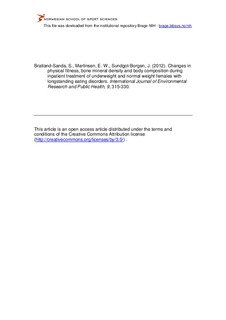| dc.contributor.author | Bratland-Sanda, Solfrid | |
| dc.contributor.author | Martinsen, Egil Wilhelm | |
| dc.contributor.author | Sundgot-Borgen, Jorunn | |
| dc.date.accessioned | 2012-11-14T12:30:34Z | |
| dc.date.available | 2012-11-14T12:30:34Z | |
| dc.date.issued | 2012-01-19 | |
| dc.identifier | Seksjon for idrettsmedisinske fag / Department of Sports Medicine | |
| dc.identifier.citation | International Journal of Environmental Research and Public Health. 2012, 9, 315-330 | no_NO |
| dc.identifier.issn | 1660-4601 | |
| dc.identifier.uri | http://hdl.handle.net/11250/171046 | |
| dc.description | © 2012 by the authors; licensee MDPI, Basel, Switzerland. | no_NO |
| dc.description.abstract | The purpose of this study was to examine changes in aerobic fitness, muscular strength, bone mineral density (BMD) and body composition during inpatient treatment of underweight and normal weight patients with longstanding eating disorders (ED). Twenty-nine underweight (BMI < 18.5, n = 7) and normal weight (BMI ≥ 18.5, n = 22) inpatients (mean (SD) age: 31.0 (9.0) years, ED duration: 14.9 (8.8) years, duration of treatment: 16.6 (5.5) weeks) completed this prospective naturalistic study. The treatment consisted of nutritional counseling, and 2 × 60 min weekly moderate intensive physical activity in addition to psychotherapy and milieu therapy. Underweight patients aimed to increase body weight with 0.5 kg/week until the weight gain goal was reached. Aerobic fitness, muscular strength, BMD and body composition were measured at admission and discharge. Results showed an increase in mean muscular strength, total body mass, fat mass, and body fat percentage, but not aerobic capacity, among both underweight and normal weight patients. Lumbar spine BMD increased among the underweight patients, no changes were observed in BMD among the normal weight patients. Three out of seven underweight patients were still underweight at discharge, and only three out of nine patients with excessive body fat (i.e., >33%) managed to reduce body fat to normal values during treatment. These results calls for a more individualized treatment approach to achieve a more optimal body composition among both underweight and normal to overweight patients with longstanding ED. | no_NO |
| dc.language.iso | eng | no_NO |
| dc.publisher | MDPI | no_NO |
| dc.subject | eating disorders | no_NO |
| dc.subject | psychiatry | no_NO |
| dc.subject | females | no_NO |
| dc.subject | adult | no_NO |
| dc.subject | exercise | no_NO |
| dc.subject | VO2max | no_NO |
| dc.subject | resistance training | no_NO |
| dc.title | Changes in physical fitness, bone mineral density and body composition during inpatient treatment of underweight and normal weight females with longstanding eating disorders | no_NO |
| dc.type | Journal article | no_NO |
| dc.type | Peer reviewed | no_NO |
| dc.subject.nsi | VDP::Medical disciplines: 700::Health sciences: 800 | no_NO |
| dc.source.pagenumber | 315-330 | no_NO |
| dc.source.volume | 9 | no_NO |
| dc.source.journal | International Journal of Environmental Research and Public Health | no_NO |
